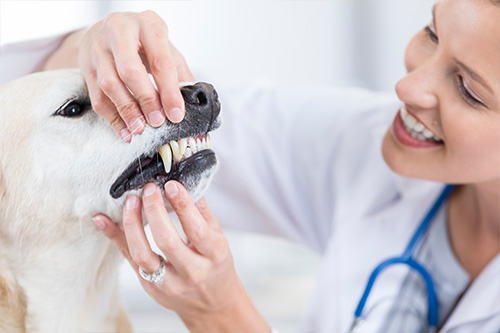
Pet dental care is as important to your dog or cat as it is to our human family members. Veterinary Medical Center of Folsom provides comprehensive pet dental care through regular exams, cat and dog teeth cleaning, and helping pet owners to create a manageable home dental care program.
PET DENTAL DISEASE
Pet dental disease causes bad breath, tooth loss, and pain. Mild dental disease is called gingivitis and is characterized by tartar on the teeth and inflamed gums. When gingivitis progresses to periodontal disease, the bone around the roots of the teeth becomes infected and begins to recede. Periodontal disease jeopardizes the teeth and allows bacteria into the bloodstream. The most common areas to become infected in this way are the heart valves and the kidneys. This danger increases as the age of your pet advances, because of altered blood flow through these organs and a waning immune system.
Your Veterinary Medical Center of Folsom veterinarian is best qualified to tell when it is time for your pet’s dental cleaning, but you can get a pretty good idea at home by looking in your pet’s mouth. You will know to call us if you see:
- Build-up of hard, brown material on the teeth
- Gums that are puffy or redder on the edge than the adjacent tissue
- Loose or broken teeth
- Bleeding, lumps, or sores in the mouth
Pets that have dental issues may be in constant pain, as well. Indicators of oral pain include refusal to eat; pawing at the face; excessive drooling; discharge or swelling around the face, nose, or eyes; and a reaction to mild pressure in the mouth area. A good oral exam will find any problems. Of course, contact us at once if you see any indication of pain or problems in your pet’s mouth.
PET DENTAL PROCEDURES
Anesthesia is needed for your pet’s dental procedure in order to adequately clean every surface of every tooth, including under the gum line, and to evaluate the condition of each tooth to determine if an extraction or further tooth care is needed. Another benefit to having your pet anesthetized during the procedure is that we are able to do a thorough exam of the mouth, gums, tongue, and throat—this thorough exam would be virtually impossible to perform while your pet is awake. We recommend to run blood work before embarking on dental anesthesia. That way, any metabolic abnormalities will be picked up as part of the dental procedure.
We use a very safe gas anesthesia called isoflurane. Your pet breathes nearly 100% oxygen through a tube that goes in their trachea, which attaches to an anesthetic machine that mixes a tiny amount of the anesthetic with the oxygen. The tube also prevents any of the dirty water generated in the cleaning process from getting into your pet’s lungs.
Our procedures even take into account senior pets. We don’t feel that younger pets deserve less of a safety procedure than a senior pet. As a result, ALL pets that go through this relatively safe procedure get the attention of a dedicated Vet Assistant to monitoring the health of your pet during the entire procedure. Ask us about what else we do to ensure a better quality and service and mitigate the relatively low risks associated with anesthesia.
QUICK NOTE:
About “anesthesia-free” dentistry: As you can imagine, it is virtually impossible to properly clean and evaluate your pet’s teeth without anesthesia. Anesthesia-free dentistry in pets only removes the tarter that you, the pet owner, can easily see on the cheek side of the teeth. Removal of tarter and plaque from the inside of the teeth, in between the teeth, or below the gum line can’t be done. And, the teeth cannot be probed and evaluated well without anesthesia. As a pet owner, you are lulled into a false sense that your pet’s teeth have been adequately cleaned when they have not. This leads to further decay and infection below the gum line, in the bone, or in the tooth root resulting in tooth loss, discomfort, and disease.
